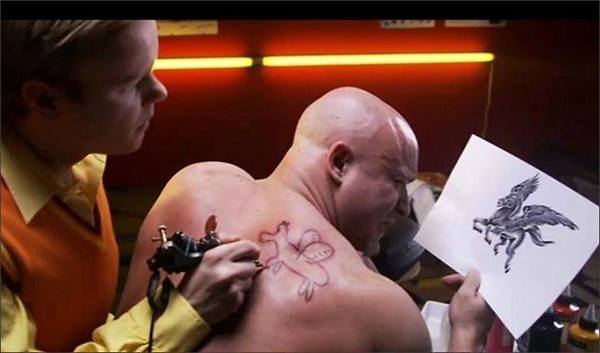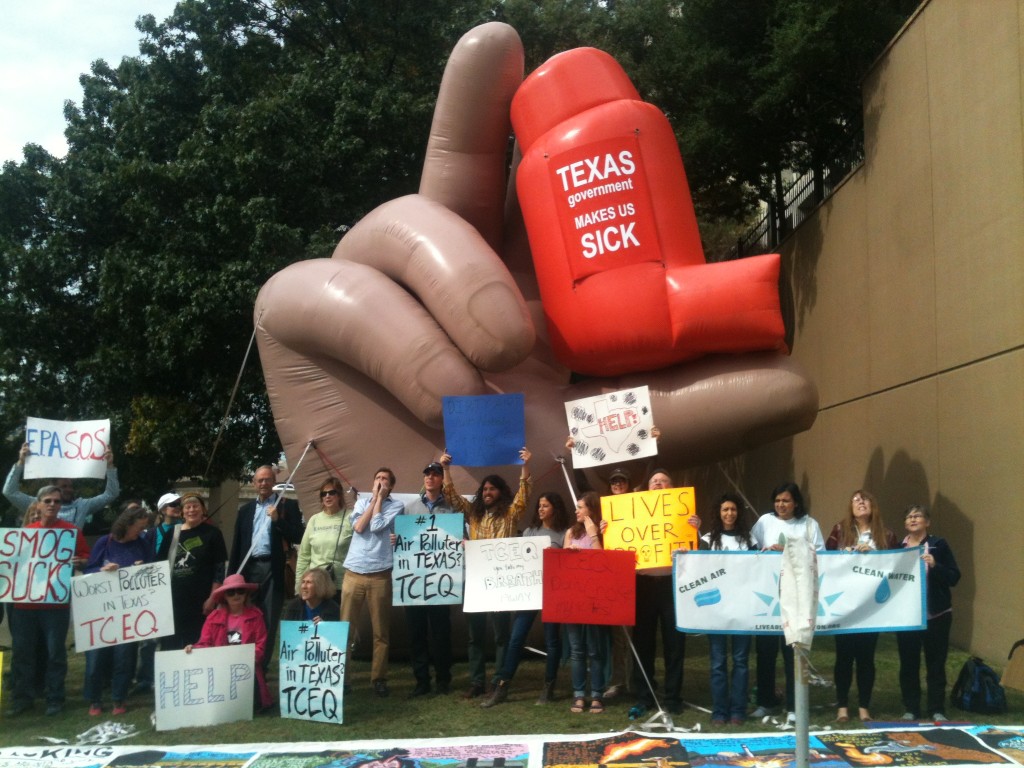TCEQ: New Smog Numbers Widen Clean Air Gap, But Still “Close Enough”
 Only an hour after a public plea to EPA by local residents to rescue them from the state's laissez-faire enforcement of environmental laws, the Texas Commission on Environmental Quality proved the protesters' point at last Friday's regional air quality meeting by announcing a bigger gap between the current federal smog standard and the Commission's anti-smog plan supposedly designed to meet that standard in DFW.
Only an hour after a public plea to EPA by local residents to rescue them from the state's laissez-faire enforcement of environmental laws, the Texas Commission on Environmental Quality proved the protesters' point at last Friday's regional air quality meeting by announcing a bigger gap between the current federal smog standard and the Commission's anti-smog plan supposedly designed to meet that standard in DFW.
The goal is to average 75 parts per billion (ppb) or less of ozone in the air over any single eight hour period at all 20 DFW monitors by 2017, per a court order that rolled the deadline back from 2018. DFW is at 83 ppb now. TCEQ announced its latest estimates have DFW clocking-in a best case scenario of 77.8 parts per billion by the end of 2017.
But don't worry, because TCEQ says that's still "close enough" to 75 to count as a bulls-eye.
One wonders what would happen if this kind of precision was practiced in other critical fields. Your surgeon mistakes your Thoracic Aorta for the Abdominal Aorta? Understandable, they both start with "A." Bank statement off by a decimal point or two? Surely not enough of a change to worry about.
And is a jump of almost two parts per billion in regional smog over the last estimate any reason for perhaps considering new smog controls for major sources of pollution, like, say, cement plants, coal plants, or oil and gas sources? Nope, says TCEQ. No need to inconvenience those industries because of some little ol' public health harms that we as a state agency have been trying to downplay and deny for years now.
"2 to 3 parts per billion here, 2 to 3 parts per billion there – what's the difference" TCEQ asks? "We'll throw in things the EPA can't possibly quantify – like 'sustainable building' and 'bicycle paths' and Viola! we'll get down to "77" ppb in two years with no problems…somehow. That's within the margin of error – that we always blow past. We've always relied on this tried and true approach of aiming low and we've had great success so far, we're 0 for 5 in reaching attainment on time over the last two decades."
Co-facilitating this charade to some extent is EPA itself, which still allows state governments to round DOWN 77.8 to 77, knocking off almost a whole part per billion in TCEQ's always-sunny scenario on paper, if not in the actual atmosphere of 2018, where it counts more.
Particularly galling about the state's lackadaisical approach to meeting the current 75 standard is that it comes at a time when we know that number is still too high to adequately protect public health. EPA has just proposed lowering it to 70 ppb based on an overwhelming amount of evidence. Instead of a smog plan that always seems to come in two to three parts per billion over the standard, how about we draft one that comes in at one to three parts per billion under the standard? One that anticipates the need to get even cleaner air in the future and gives us a running start?
As it turns out, we have fresh evidence, provided by the state's own computer model, that requiring off-the-shelf modern pollution controls on those cement kilns, coal plants, and oil and gas facilities could lower DFW regional smog by at least one to two parts per billion, putting us in a much more likely position to actually meet the smog standard. TCEQ looks at this result, wrinkles up its collective nose and says its only a one or two parts per billion change. To which the logical reply is: "OK, show us how you get down closer to 75 ppb without cuts in emissions from those major sources."
Crickets.
Because of course, TCEQ has no alternative, no Plan B, no way to get down to the 75 ppb standard that involves doing something. It isn't invested in that goal. As its website explains, the Commission's "customers" are the industries seeking its permits. Many of those customers are very upset at the mean ol' EPA for following the Clean Air Act. And the customer is always right.
So TCEQ drafts a customer-friendly clean air plan for DFW with no controls on any major sources, makes a new federal gasoline mix do most of the work in the computer model, and (theoretically) crosses the finish line at three parts per billion over the standard. See how hard they tried?
The last time TCEQ tried as hard was the 2011 DFW clean air plan. That "do-nothing" plan was predicted by the state to take us to historically low smog levels because so many more new cars were going to be purchased – during the Great Recession. All we had to do was sit back and watch those babies fly off the lots!
It was the first DFW clean air plan in 20 years to actually produce higher smog levels.
First, but maybe not the last. Regional smog averages rose twice this summer – the first of three that make up a running annual average determining success or failure of the TCEQ plan by 2017. How do you know when a TCEQ clean air plan is being implemented? Smog goes up.
EPA's own modeling is already predicting TCEQ's current "do-nothing" plan won't work, and concludes DFW will be one of only a hand full of metropolitan areas still breathing unsafe and illegal air ten years from now.
In point of fact, no matter how many parts per billion, no gap would be wide enough for TCEQ to find cause for more pollution controls on major sources. They've rigged the game to produce a result they hope allows them to slide by and get EPA approval. It's our responsibility to make sure EPA doesn't give it.
Texas state government has no intention of trying to meet the federal smog standard. It has every intention of dragging out the process so it's unwillingness to implement measures to meet it are obscured by more deadline failures and new Designed-to-Fail plans from Austin. It is a never-ending cycle there's no escape from as long as TCEQ is in charge. Expecting Texas to vigorously enforce environmental laws in 2015 is like expecting Mississippi to enforce federal civil rights law in 1965.

That's why it's important for EPA to takeover the job.
Is it a perfect solution? No, but it's one with a beginning, middle and end, carried out by an agency that still officially believes smog is a public health threat.
PLEASE…sign the petition for a real clean air plan from EPA
AND
Only we can prevent another twenty years of dirty air.
